| Article ID | Journal | Published Year | Pages | File Type |
|---|---|---|---|---|
| 1267209 | Bioelectrochemistry | 2013 | 7 Pages |
Rapid detection of alcohol is important in clinical diagnosis and fermentation industry. An octameric alcohol oxidase (AOx) (Mr 675 kDa) from Pichia pastoris, immobilized on multiwalled carbon nanotubes—Nafion® (MWCNT-Nf) matrix and encapsulated with polyethylenimine (PEI) on gold electrode (AuE), showed a redox peak at 0.21 V (vs. Ag/AgCl electrode at pH 7.5) for oxidation of alcohol. The electron transfer rate constant and surface coverage of the immobilized AOx were 1.69 ± 0.15 s− 1 and 2.43 × 10− 12 mol cm− 2, respectively. Studies on response and kinetics of Au-MWCNT‐Nf‐AOx-PEI bioelectrodes for alcohol showed a linear response in the range of 8 μM–42 μM, response time of 55 s for steady state current, and detection limit of 5 μM. The bioelectrode retains ~ 90% of the original response even after four weeks when stored in potassium phosphate buffer pH 7.5 at 4 °C. The fabricated bioelectrode was found to exclude interference caused by the common electroactive species such as ascorbic acid, uric acid, lactic acid, glucose and urea. The bioelectrode also showed reliable response characteristics in blood serum samples. The findings of the investigation have established the direct electrochemistry of the AOx protein and its potential biosensor application for quantitative detection of alcohol in blood serum.
► Direct electrochemistry of alcohol oxidase in carbon nanotube matrix-based bioelectrode was established. ► The bioelectrode showed reliable response characteristics in the sample. ► Nearly 90% of the original response of the bioelectrode retained even after four weeks. ► The bioelectrode excluded interference caused by the common electroactive species of body fluid.
